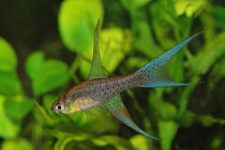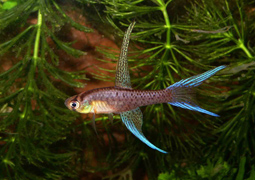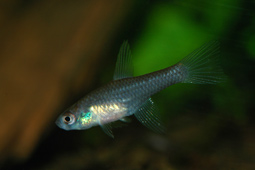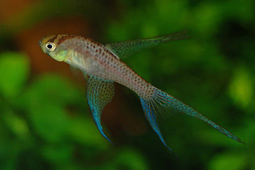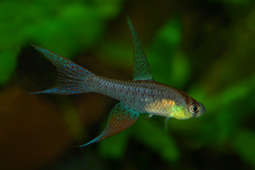History
Both authors described this species as Austrofundulus dolichopterus six years after its discovery by Leo Emile Hoigne in December 1961.
Dr. Donald Taphorn from Guanare, Venezuela & Prof. Jaimy Thomerson, USA erected the genus Terranatos for this small beautiful species as they came to the conclusion that it was no longer possible to keep it within the Austrofundulus family. This genus name is referring to the way of life that this species lives as it emerges from the mud after the rains fall and the water fills the completely dried- out pools again. ("Terra" = earth- and "natos"- birth)
In 1993, the discovery of Terranatos more to the border of Colombia at Isla Raton, in the Rio Orinoco just somewhat south of Puerto Ayacucho, by Roger brousseau widened the territory in wich the species was espected to live. This variant had nice orange colors in the fins, especially in the Anal fin and sometimes in the first rays of the dorsal fin. This confirms that the species has a wide range of distribution along the upper Rio Orinoco river.
Females do not show any markings on body or fins and have a light brown color and the fins are not as long as in males.
Reproduction
Breeding Terranatos dolichoptherus is for specialists that do know how to breed annuals in general. Even for them it is not easy to maintain the species for a longer period of time. The eggs are small, but the species is very productive and a single trio can produce up to 100 eggs in a week. The problem starts with the incubation and the long time they need to get developed. For some reason many eggs vanish during this developing time. Often because of bad fertilisation but also as result of low pH levels in the peat. It is good to understand the species lives in open areas, sometimes with low secundary forests around but mostly in complete open terrain. The bottom is always build up of clay, mostly soft grey clay and the waters these fishes live in are seldom clear, in fact always turbid by the clay. The turbid water in the ponds can get a little bit acid, the clay however never will become lower in pH as neutral.
The time that eggs need to come thru the various diapauses depends on humidity and temperature. Normal we use a humidity that equals the humidity of fresh tobacco. This in combination with a temperature of about 24 C will result in a developing time of 6 months.
Some expiriments showed a remarkable speeding of this process. If temperatures are raised up to 30 C or even higher and humidity is a little bit higher also the eggs can be ready in 40 days also. I tested this on my addict and temperature there are 36 C during the afternoon and fall down till 26 C during the night. With this situation it easely happens however that eggs start to fungus. So, the higher the humidity the easier the fungus can damage the eggs.
I would recommend a temperature between 28 and 30 and slightly higer than normal humidity. Under this conditions eggs are ready to hatch at 3-4 months.
As stated, eggs are small and the fry is very small too. For this species it is wise to feed them the first days with infusoria. After a few days start with just hatched brine shrimps and feed them well. They grow very quick if water is changed bi- daily and food is all day at hand. Even if food is plenty, separate the bigger ones from the smaller ones during the first weeks. Males grow faster and can minimize the number of females by eating them.
Terranatos is a peaceful species as long as you keep many animals together. If a tank has 2 males often one of them will die as result of constant fights. Place 2 - 3 females to one male and give them a place to put their eggs deep in the ground. Use coco- peat only and boil this for about a half hour first and rinse it afterwards to get ridge of fine dust and low pH values.
Remarks :
Variations
Map
Puerto Ayacucho location map Right click to open in new window.
El Baśl location map Right click to open in new window.
Meristics
Max. size 4.5 cm.
Dorsal 13.1,
Anal 15.8,
D/A -3.4,
LL scale count (average)26.1
Pre- dorsal length to % SL – 50.2 %
Depth to % SL – 29.7 %
Literature
Taphorn, D.C. & J.E. Thomerson. 1978. A revision of the South American Cyprinodont Fishes of the Genera Rachovia and Austrofundulus, with the Description of a new Genus. Acta. Biol. Venzuela, 9 (4): 384.
